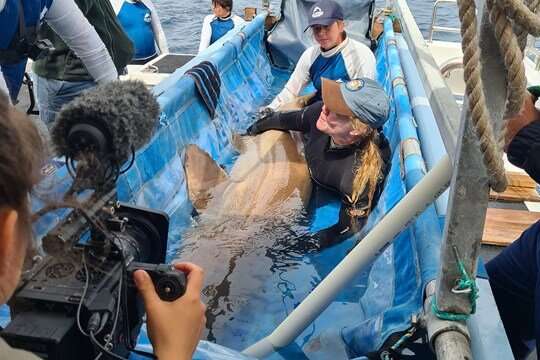This article has been reviewed according to Science X's editorial process and policies. Editors have highlighted the following attributes while ensuring the content's credibility:
fact-checked
peer-reviewed publication
proofread
Study finds double threat for endangered Australian east coast shark

A slow birthrate and night-time wanderings of pregnant gray nurse sharks away from no-take marine protected areas are putting the fierce-looking but mild-mannered species at further risk of extinction.
A 10-year study that tagged and tracked 34 gray nurse sharks migrating between the Great Barrier Reef and southern New South Wales identified the double threat for the critically endangered species, which has only about 400 breeding animals left in the wild.
The collaborative research led by Dr. Ross Dwyer of the University of the Sunshine Coast and Dr. Carley Kilpatrick from the Queensland Parks and Wildlife Service (QPWS) found the migratory sharks regularly visited no-take MPAs established along the east coast of Australia.
This included Wolf Rock, northeast of Double Island Point; Flat Rock north of North Stradbroke Island; and Henderson Rock and Cherubs Cave, east of Moreton Island.
All are popular spots for scuba diving tourism in Queensland, with the gray nurse shark not considered a risk to human safety.
Dr. Dwyer, a UniSC animal ecology academic, said Flat Rock, Henderson Rock and Cherubs Cave were used for several weeks each year (during winter—early summer) by migrating male and female sharks.
"In contrast, Wolf Rock was particularly important for pregnant female sharks which would stay at the site for up to 254 days during their gestation. However, sharks regularly left the relative safety of the MPAs, often in darkness," Dr. Dwyer said.
"These excursions will likely increase the risk of them becoming bycatch—getting accidentally caught in commercial or recreational fisheries or in shark control equipment along beaches."
The findings were published this month in the journal Biological Conservation, in a paper co-authored by nine partners from The University of Queensland, QPWS, NSW Department of Primary industries, Sydney Institute of Marine Science, and Macquarie University.
One of the tracked female sharks was initially captured as an immature shark in August 2015, after she was observed by members of the public off North Stradbroke Island with a stainless-steel rod protruding through her stomach.
Following surgery and a period of rehab at Sea World Gold Coast, she was detected five years later with fresh mating scars at Cherubs Cave enroute to Wolf Rock.
Dr. Kilpatrick, a Senior Conservation Officer and gray nurse shark expert with QPWS, said Wolf Rock was the only known gestation site for the Australian east coast gray nurse population.
"These night-time excursions suggest the existing no-take MPA at Wolf Rock needs to be larger to protect sharks in areas we now know they use, and help ensure the species' long-term conservation," Dr. Kilpatrick said.
"The tracking also revealed a longer than expected three-year migratory cycle linked to breeding. This slow reproductive rate, with females not breeding until they are at least nine years old and having a maximum of two pups at a time, highlights why the population has been so slow to recover.
"The research highlights how our no-take MPAs do a great job of protecting gray nurse sharks while they congregate in them. Our concern is that they are spending a lot more time outside of the no-take MPAs than we thought; including areas adjacent to no-take MPAs such as Wolf Rock."
Dr. Dwyer said the study used for the first time a novel combination of latest animal tracking technology and shark counts by citizen scientists.
"The study was a massive collaborative effort, and we'd like to thank everyone who helped count and tag the sharks, and maintain over 300 moorings along the Australian east coast where these tagged gray nurse sharks were detected—from Heron Island in the Great Barrier Reef to Montague Island in south east New South Wales," he said.
"This approach produced accurate, valuable data and can now be applied to other migratory coastal shark species to ensure marine area networks offer maximum protection benefits."
More information: Ross G. Dwyer et al, Marine reserve use by a migratory coastal shark, Carcharias taurus, Biological Conservation (2023). DOI: 10.1016/j.biocon.2023.110099
Journal information: Biological Conservation
Provided by University of the Sunshine Coast


















